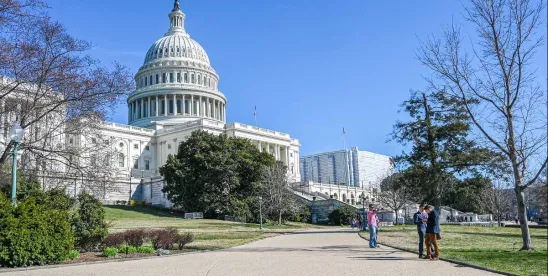The Beltway Buzz is a weekly update summarizing labor and employment news from inside the Beltway and clarifying how what’s happening in Washington, D.C., could impact your business.
Biden Announces Nominations to NLRB. This week, President Biden announced that he would renominate Lauren McFerran, chair of the National Labor Relations Board (NLRB), for another term. (Her current term expires on December 16, 2024.) He will also nominate Joshua L. Ditelberg, a management attorney, to fill the Republican seat on the Board that has been vacant since December 2022. If McFerran is confirmed, Democrats will remain in the Board majority until at least August 2026, regardless of which presidential candidate prevails in the November elections later this year. It will be interesting to watch the nomination process unfold. Business groups have been critical of President Biden’s refusal to fill the vacant Republican seat, but if the price to pay is Democratic hegemony, the political maneuvering could become complicated.
DOL’s Overtime Rule Challenged. This week, business groups joined together to file a legal challenge to the U.S. Department of Labor’s (DOL) overtime regulations. The complaint, which was filed in the same federal court that invalidated the DOL’s 2016 overtime rule, argues that the latest rule “largely repeats the errors of the 2016 Rule and fails to address the flaws previously identified by this Court.” The complaint argues that the dramatic increase to the salary basis threshold exceeds the agency’s authority because it eviscerates the statutory exemptions to the Fair Labor Standards Act (FLSA) overtime requirements established by the U.S. Congress. Plaintiffs further argue that the automatic escalator provision of the rule violates the Administrative Procedure Act’s (APA) notice-and-comment requirements and that the DOL failed to adequately explain its change of policy. Because the first phase of the salary increase is scheduled to take effect on July 1, 2024, the complaint requests the court to conduct its review expeditiously.
OSHA Walkaround Regulation Update. This week, legislators and business groups took steps to push back on the Occupational Safety and Health Administration’s (OSHA) controversial walkaround regulation.
- Legal Challenge Filed. A coalition of business groups filed a lawsuit challenging the regulation in the U.S. District Court for the Western District of Texas. The complaint alleges that OSHA exceeded its statutory authority in promulgating the rule and violated the APA because the agency did not adequately explain its expansion of existing regulations and failed to consider alternatives. The complaint also alleges that the regulation infringes on property owners’ rights to exclude third parties and is therefore an unconstitutional taking under the Fifth Amendment of the U.S. Constitution.
- Congressional Review Act Resolution. Late last week, Republicans in the U.S. House of Representatives, led by Congresswoman Mary Miller (R-IL), introduced a Congressional Review Act (CRA) resolution to rescind the walkaround rule. The CRA allows Congress —with simple majority votes in each chamber—to rescind agency regulations. However, even if the resolution is approved in both the House and U.S. Senate (which is certainly possible, as some Democrats and Independents have been willing to join Republicans on other CRA resolutions during this Congress), President Biden is likely to veto the measure—like he did with the joint employer resolution. Even in the face of a presidential veto, the resolution is indicative of the growing controversy surrounding the rule.
CRA Clock Is Ticking. Speaking of the CRA, the statute is likely a significant reason why the administration has recently finalized a spate of regulations. This is because the CRA allows a new Congress to review “midnight regulations” that are finalized within sixty days of the adjournment of the prior Congress. Many regulatory wonks are predicting that regulations finalized after this week could fall within sixty days of adjournment of the current 118th Congress, therefore making them vulnerable to potential rescission by a Republican Congress and president in 2025. The administration obviously does want to give the 119th Congress—set to gavel in in January 2025—an opportunity to use the CRA to rescind aspects of President Biden’s regulatory agenda, so it is rushing to finalize rules sooner rather than later. This CRA look-back provision has undoubtedly been a driving force for the DOL’s recent finalization of its independent contractor rule, overtime rule, walkaround rule, and the Federal Trade Commission’s non-compete rule, among other regulations.
OSHA Finalizes Changes to HazComm Standard. On May 20, 2024, OSHA published a final rule updating its Hazard Communication Standard (HCS). The changes are intended to align the HCS—which hasn’t been updated since 2012—with 2017 changes made to the Globally Harmonized System of Classification and Labelling of Chemicals (GHS). The amendments include revised criteria for classification of certain health and physical hazards, revised provisions for labels, amendments related to the contents of safety data sheets, and new provisions relating to trade secrets. The regulation goes into effect on July 19, 2024, though phased-in compliance dates don’t begin until January 2026.
House Subcommittee Examines Union Organizing Tactics. On May 22, 2024, the U.S. House of Representatives Subcommittee on Health, Employment, Labor, and Pensions held a hearing entitled, “Big Labor Lies: Exposing Union Tactics to Undermine Free and Fair Elections.” The hearing focused on smear campaigns to bully employers into acquiescing to union demands, so-called “neutrality agreements” that prevent employers from discussing with employees the pros and cons of unionization, and union “salts”—professional union organizers who secure employment at a nonunion employer with the sole intention of organizing the workforce. Republicans used the hearing to promote legislation such as the Employee Rights Act, the SALT Act, and the Worker’s Choice Act, which would eliminate exclusive representation and allow employees who opt out of union membership to negotiate their own terms and conditions of employment. On the other hand, Democrats took the opportunity to promote the Protecting the Right to Organize (PRO) Act. All of these bills are real legislative longshots, but the hearing demonstrates the significance of the policy issues at stake during an election year.
The Homestead Act of 1862. On May 20, 1862, President Lincoln signed the Homestead Act of 1862 into law. Distribution of federal land to private owners had been a tricky problem, particularly as the United States began to expand. Many Northerners favored the practice of homesteading, in which individual farmers would own and improve their own parcels of land, while Southern slave owners wanted to acquire massive tracts of land to extend slavery to the territories. With the outbreak of the Civil War, the Southerners’ argument became moot and the Homestead Act was enacted. The act provided up to 160 acres of land to adult citizens—including women, formerly enslaved persons, and immigrants who filed an intention to become citizens—who did not fight for the South in the Civil War. Homesteaders could acquire permanent title if they remained on and improved the land for five years, which was no easy task on the American frontier of the mid-1800s. More than 270 million acres of land were distributed through the Homestead Act of 1862, which was eventually repealed by the Federal Land Policy and Management Act of 1976.




 />i
/>i

